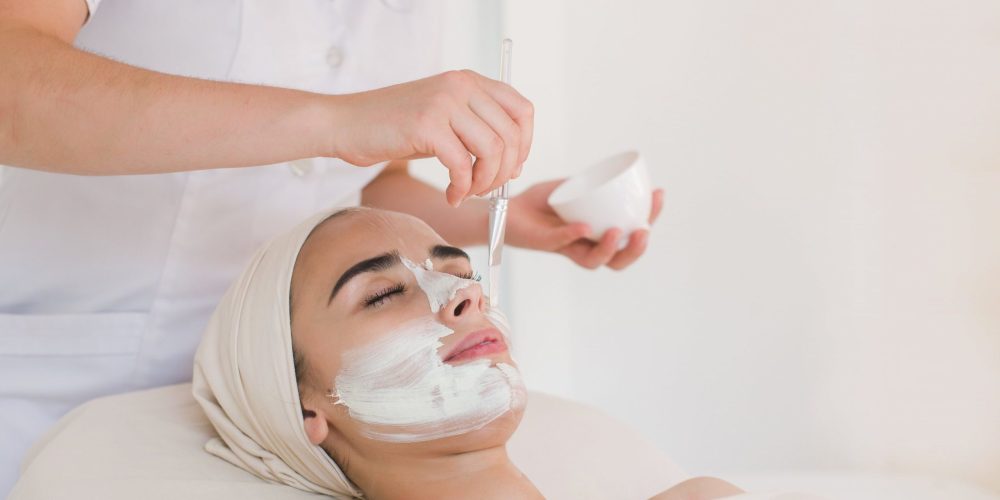A chemical peel applies hazardous chemical substances to the skin in a regulated manner, resulting in skin cells’ controlled death. The extent of the wound is determined by the ailment that is being treated. The skin regenerates as a result of the peel. Deep layers of the epidermis recover, as does the superficial dermis.
What are the many types of chemical peels available?
Chemical peels are generally classified according to the amount of skin damage they cause when applied to the skin. Depending on their depth, they can be classified as superficial, medium, or deep.
Superficial peels do not cause any damage to the skin underneath the epidermis, which is the most superficial layer. Medium peels can penetrate the superficial layer of the dermis, which is the deeper layer of skin. On the other hand, the deep peels are more likely to reach the deeper layers.
The type and intensity of the chemicals in the peeling solution and the amount of time they are allowed to interact with the skin determine the extent of the skin damage that occurs.
What are the conditions that a chemical peel can help with?
Chemical peels are most frequently used on the face, neck, and hands. They can aid in the reduction or improvement of:
- Sun damage, aging, and inherited causes generate fine lines beneath your eyes and creasing around your lips.
- Acne of certain sorts.
- Scarring that is not severe.
- Age, sun, liver, freckles, and uneven skin color are all examples of skin imperfections.
- Actinic keratosis is a precancerous scaly patch.
- Rough skin, scaly areas, and a drab appearance.
- Melasma (dark patches) is associated with pregnancy or birth control medications.
Is a chemical peel suitable for all types of skin?
In general, all types of skin can benefit from superficial peels. However, if you have a darker complexion, you are more likely to have skin darkening after treatment. Post-inflammatory hyperpigmentation is the medical term for this syndrome. If you have naturally darker skin, consult your dermatologist about other, less invasive treatments that can help you avoid hyperpigmentation.
Chemical Peels when Done by Experts
Although superficial peels do not usually require an anesthetic, they cause a burning sensation whenever the solution is administered. The use of cool compresses and fan-assisted evaporation can help alleviate this. Deeper peels frequently necessitate a combination of local anesthetic, systemic sedation, and, in rare cases, general anesthetic.
The peeling procedure begins with using a defatting solvent (acetone or alcohol) to the treatment region in a uniform manner. The chemical peel is then administered for the proper time before stopping with a neutralizing solution.
After the doctors apply bandages to the treated area, the patient is sent home to recover. The recovery period depends on the type of peel and can take months. Peels are often not covered by typical health insurance policies because they are considered cosmetic operations.
What Are the Side Effects of Getting a Chemical Peel
Redness, stiffness, stinging or burning, and mild swelling are common transient side effects. Deep peels may lead to losing your ability to tan permanently.
On the other hand, chemical peels can have more severe hazards and long-term adverse effects. These are some of them:
- The color of the skin darkens or lightens. People with darker skin are more likely to have them.
- Scarring. This could be a long-term situation.
- Infections. Herpes simplex patients may develop flare-ups after treatment. Chemical peels can induce fungi and bacteria infections in rare cases.
- Damage to the heart, liver, or kidneys. Deep peels contain phenol, harming the cardiovascular system, kidneys, and liver and inducing irregular heartbeats.
A recovery period will be required for all patients, the duration of which will be determined by the depth of the peel. Deep peels might take weeks to heal, depending on the severity of the peel. Deep peels usually necessitate a lot of local anesthetic, conscious sedation, and, on rare occasions, general anesthesia, which comes with its own set of hazards.
Side effects of chemical peels
The intensity, severity, and type of peel you employ will impact the adverse effects you may encounter.
Lightweight peeling, such as 15 percent salicylic or 25 percent mandelic acid, will have little to no side effects. After the peel, there will be some redness, but it should fade away in an hour or two. Skin peeling may occur after 2 or 3 days. On the other hand, light superficial peels are far less prone to induce this.
It’s crucial to remember that just because something isn’t peeling doesn’t mean it’s not working! Don’t underestimate its potency, even if you think a chemical peel didn’t do much.
Aftercare for Chemical Peels
You should avoid using active chemicals like tretinoin (Retin-A) or products containing acids like glycolic or salicylic acid in your skin for at least the following 24 hours.
You must follow up with a straightforward, bland skincare program following a peel. Utilizing a hyaluronic acid solution can help hydrate your skin, and studies have shown that hyaluronic acid plays a crucial part in wound healing – two things you should be focusing on.
Moisturizers that reinforce and restore the moisture barrier are also a good idea. Look for skin-identical components, including ceramides, and hyaluronic acid, which helps repair barrier damage and improve the moisture barrier.
CeraVe PM is a preferred moisturizer because it contains 4% niacinamide, a powerful antioxidant that:
Anti-aging benefits by brightening skin tone and increasing collagen production
CeraVe Cream, on the other hand, comes in a close second and is better suited to persons with dry skin.
Vaseline is another fantastic and affordable product to use after chemical peels. Petrolatum is noncomedogenic, contrary to popular perception. Because its molecules are too large to block pores, it cannot clog them.
The most efficient component for preventing transepidermal water loss (TEWL), which maintains skin hydration and is moisturized, is petroleum jelly. Make sure you’re using petroleum jelly if you want to expedite the recuperation time after a chemical peel.
Finally, but certainly not least, use sunscreen and safeguard your skin from sun damage soon after your peel. Your skin will be quite delicate.
Chemical peels are available at Isla Aesthetics in various solutions to suit your needs! The clinic’s comprehensive chemical peel services address fine lines, creases, acne and acne scars, hyperpigmentation, and texture.




